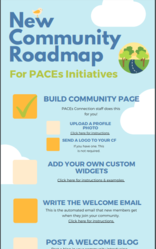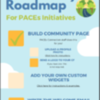There may have been attendees with more questions than answers following a recent webinar on federal funding coming as the result of the American Rescue Plan Act. But much was made clear in the webinar sponsored by PACEs Connection and the Campaign for Trauma Informed Policy and Practice (CTIPP).
For star ters, said Marlo Nash, “The pandemic is continuing to impact physical, mental, social, and economic health, and pretty much every public system and the people who are in those systems. It also continues to lay bare structural and racial inequities that predate the pandemic." Nash is policy advocate, systems strategist and member of the CTIPP National Trauma Campaign.
ters, said Marlo Nash, “The pandemic is continuing to impact physical, mental, social, and economic health, and pretty much every public system and the people who are in those systems. It also continues to lay bare structural and racial inequities that predate the pandemic." Nash is policy advocate, systems strategist and member of the CTIPP National Trauma Campaign.
“The American Rescue Plan is designed to help with all of that, and the guidance is making it very clear that the money can be used not only to address issues that the pandemic has caused, but it also can be used to address the structural and racial inequities that were in place before the pandemic,” Nash continued.
The almost $2 trillion American Rescue Plan Act has several buckets of funding that can be used to promote trauma-informed and healing-centered projects, said Nash and CTIPP Executive Director Jesse Kohler.
Both CTIPP leaders and those from PACEs Connection are encouraging communities to sit down and talk to local and state leaders, to help influence where the money goes.
“The American Rescue Plan Act offers historic financing wins, like cutting child poverty in half. It is the largest one-time investment from the federal government in childcare and offers levels of funding for state, local, and tribal governments that are very very flexible funds,” Nash said.
“Your public leaders are challenged and they really need to have kind of plug-and-play solutions where you come in with a whole plan thought out. So really, really think through what you could propose to them. They are in different places in their understanding of what is encompassed in the term ‘mental health’. Part of the advocacy is to help them understand how trauma-informed and healing-centered approaches fit within mental health,” she continued. “You may have to make the case to help them understand that where the law says mental health, it actually can pay for trauma-informed and healing centered approaches.”
Nash and Kohler also hope that PACEs Connection communities will keep each other informed about what’s happening where, and for whom, by posting stories, emailing their community facilitators, and being in touch with CTIPP via calls or email.
 “As grassroots advocates, you can help us understand what is happening in your community, so as you learn, please keep us informed,” said Kohler. “We will continue to provide the most up-to-date information possible, but your on-the-ground knowledge is our strongest resource as we learn more. Working together, we will continue to find the best opportunities to leverage funding for trauma-informed, resilience-focused, and healing-centered community practices," said Nash. “This is a historic and unprecedented opportunity to secure federal funding to see the massive, sweeping change that will truly accelerate the PACEs science and trauma-informed movement to prevent and mitigate the impacts of trauma, and help people heal, which helps communities flourish,” she said.
“As grassroots advocates, you can help us understand what is happening in your community, so as you learn, please keep us informed,” said Kohler. “We will continue to provide the most up-to-date information possible, but your on-the-ground knowledge is our strongest resource as we learn more. Working together, we will continue to find the best opportunities to leverage funding for trauma-informed, resilience-focused, and healing-centered community practices," said Nash. “This is a historic and unprecedented opportunity to secure federal funding to see the massive, sweeping change that will truly accelerate the PACEs science and trauma-informed movement to prevent and mitigate the impacts of trauma, and help people heal, which helps communities flourish,” she said.
The fact sheet, slide decks, and other information highlighted during the presentation are shared as resources in this article.
 Also shared are slide decks from Dave Ellis, executive director of the New Jersey Office of Resilience, and Dan Jurman, executive director of the Governor’s Office of Advocacy and Reform for the State of Pennsylvania. They both spoke from the vantage point of having been, at times in their careers, seeking funding. Now both are allocating funding.
Also shared are slide decks from Dave Ellis, executive director of the New Jersey Office of Resilience, and Dan Jurman, executive director of the Governor’s Office of Advocacy and Reform for the State of Pennsylvania. They both spoke from the vantage point of having been, at times in their careers, seeking funding. Now both are allocating funding.
Ellis discussed the New Jersey Action Plan, and urged people seeking funding to look through it, as there is language in it that could be helpful as they write grant applications.
He also urged communities to use the tools available on PACEs Connection, and to begin by looking at the outcomes they want.
“We have to work backward from there,” he said. He stressed the importance of working across sectors and having a core strategy around public awareness.
“Right now our focus is on law enforcement and education. You'll see a half-a-million-dollar awareness campaign come out in New Jersey—in I believe it's June—where we will be targeting those two groups,” he said.
As he allocates funds, Ellis said he hopes to move money “deep into communities, into those places and spaces where it may be no more than an individual who has an idea or an individual who's doing something that works. We want to move money in that direction, to support that, and actually bring it scale."
“We're going to do requests for ideas. We're streamlining the process that allows us to move money out of state agencies into a nonprofit deeper in the community, and get rid of all the state red tape in the middle,” said Ellis.
Ellis and Jurman are both using the model of a state agency working with a nonprofit collaborative. Both of their initiatives have communities on PACEs Connection, including a website, community building tools, updates on legislation, and best practices from other states.
 In Pennsylvania, Jurman said, “We created 48 recommendations, and really focused on three core pillars. One was changing the…culture policy and practice within state government. So doing things like adding trauma-informed language and responsibilities within the job description of every employee in the Commonwealth of Pennsylvania, making sure that every single employee in Pennsylvania gets at least introductory trauma training. And so, you know, things like that start to really embed all across (the state) so that no matter what your job is in state government, you're required to understand this. And then we worked on grassroots connectivity, and so Paces Connection was a big part of that.”
In Pennsylvania, Jurman said, “We created 48 recommendations, and really focused on three core pillars. One was changing the…culture policy and practice within state government. So doing things like adding trauma-informed language and responsibilities within the job description of every employee in the Commonwealth of Pennsylvania, making sure that every single employee in Pennsylvania gets at least introductory trauma training. And so, you know, things like that start to really embed all across (the state) so that no matter what your job is in state government, you're required to understand this. And then we worked on grassroots connectivity, and so Paces Connection was a big part of that.”
During the webinar, PACEs Connection founder and publisher Jane Stevens and Southeastern regional community facilitator Carey Sipp also spoke about the importance of beginning with the end in mind when applying for the funding. They discussed the important role of community-building as well as tracking progress and outcomes to increase the likelihood of sustaining programs over the several decades required for lasting change.
“We want communities to see the importance of growing in ways that include all sectors from their communities, and to track their progress and outcomes by using tools created by PACEs Connection,” said Stevens. “Showing data-driven outcomes will help make the case for continued funding as practices and policies based on PACEs science reduce domestic violence; improve school and work attendance; reduce school suspensions and expulsions; decrease incarcerations, illnesses, addictions, and suicides; increase job satisfaction and, hopefully, increase paychecks and opportunities for families.”
“We don’t want short-term change for a couple of years after the pandemic,” Stevens said. “We want ongoing change that, 20 to 40 years from now, sees systems restructured to create environments that drastically reduce inequality, racism and poverty. By implementing this knowledge of PACEs science, future generations won’t have to bear what we’ve regarded as the intractable problems of racism, inequity, violence, addiction, and trauma.”
Resources:
CTIPP Presentation shared May 14, 2021
- Here’s a link to the recording of the PACEs Connection and CTIPP May 14 webinar : https://www.youtube.com/watch?v=yhyV23e9f_g
- CTIPP webinar April 2021: Statewide Comprehensive Trauma-Informed Strategies (two trauma-informed states share their strategies)
- Sign up for the National Trauma Campaign to be included in other calls to action as we work toward a trauma-informed, resilience-focused, and healing-centered United States.
- Dave Ellis, the executive director for the New Jersey Office of Resilience, and Christine Norbut Beyer, commissioner of the New Jersey Department of Children and Families, cover the development of the Statewide ACEs Action Plan and release, the technical assistance center, Virtual Learning Community, the importance of community as the center of the whole initiative, and progress to date.
- More information about Dave Ellis
- New Jersey Resiliency Coalition. For additional background on the New Jersey initiative, click here for a story in PACEs Connection.
- Daniel Jurman, executive director for the Pennsylvania Governor's Office of Advocacy and Reform, covers the creation of the Trauma-Informed PA Plan and the creation of HEAL PA, a public/private coalition of nearly 150 people from all over the state focused on implementing the statewide plan, and their progress to date.
- More information about Dan Jurman. For background on the Pennsylvania initiative, click here for a story in PACEs Connection.
- Pennsylvania Trauma-informed Network
- Trauma-Informed PA: A Plan to Make Pennsylvania a Trauma-Informed, Healing-Centered State Pennsylvania
A Summary of Funding Provisions Included in the American Rescue Act
Starting and Growing a PACEs Connection Community
 New Community Roadmap for PACEs Initiatives (Not shared in webinar but available now, with links to documents and trainings to help you grow your community; uploaded below as a resource.)
New Community Roadmap for PACEs Initiatives (Not shared in webinar but available now, with links to documents and trainings to help you grow your community; uploaded below as a resource.)
Bios:
Stay tuned for additional webinars and articles for information on how to apply for funding, and examples of how people and organizations are applying for funding.






Comments (0)